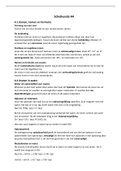Resume
Summary Econometrics 19/20 - Using econometrics; a practical guide, A.H. Studenmund
- Cours
- Établissement
- Book
Summary Econometrics Book: Using econometrics; a practical guide A.H. Studenmund, seventh edition Chapters: 1.1 - 1.5 2.1 - 2.4 3.1 - 3.3 4.1 - 4.4 5.1 - 5.6 6.1 7.1 - 7.5 8.1 - 8.5 9.1 - 9.4 12.4 - 12.5 16.1 - 16.3
[Montrer plus]













